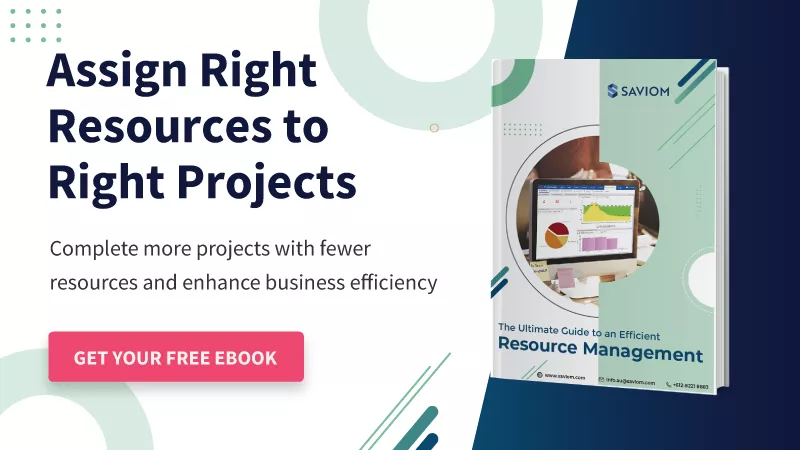Most individuals often misconstrue the difference between resource and project management, thinking that resource management is a subset of project management. Therefore, it was a common notion that all resource-related issues can be addressed by a project management tool.
However, it has now been established that resource management is a separate discipline that complements project management and other applications such as ERP, PPM, CRM, HR, and more.
Project management primarily focuses on successful execution and delivery of individual projects within defined parameters. On the other hand, resource management takes a broader organizational perspective, ensuring optimal utilization of resources across various projects and departments.
This article explains the key differences between resource management and project management.
Before that, let’s start with the basics.
Read on.
Project management definition
Project management is the process of creating a project plan and scheduling resources to tasks to meet delivery commitments. It involves applying knowledge, skills, methodologies, and techniques to fulfill project requirements effectively. Additionally, it includes defining the project scope, ensuring deliverable quality, setting deadlines, managing budgets, and achieving the desired goals in line with client expectations.
Resource management definition
Resource management is the process of effectively and efficiently utilizing business resources, including personnel, tools, assets, etc. The primary aim of resource management is to manage project resource requirements. It is done by leveraging the organization’s existing talent pool or hiring new resources as appropriate. It also includes ensuring timely allocation, optimal resource utilization, and effective communication between the workforce to provide the desired ROI.
Now, let’s examine what is the difference between project management and resource management.
Comparison between resource management and project management
In this section, we look at the basic concepts around these two terminologies, shedding light on what sets them apart despite their perceived similarities.
Goal
The goal of resource management is to ensure that organizational resources are optimally utilized across all projects. It focuses on identifying and assigning the right people with the right skill sets to suitable tasks at the right time and cost. At the same time, it helps maximize billable utilization of the workforce. Consequently, resource management helps reduce labor costs, boost project performance, and enhance profitability.
On the other hand, the primary objective of project management is to ensure seamless execution of projects within the stipulated time and budget. This involves extensive planning and implementation of different project methodologies and techniques. Effective project management focuses on achieving specific objectives or deliverables, meeting client or stakeholder requirements, and delivering value to the organization.
Approach
Resource management focuses on aligning resource skills with project demand. Here, resource managers are responsible for overseeing the resource requisition process initiated by the project managers. Based on the requirements, they will identify and assign suitable employees to appropriate project vacancies or allocate placeholders in case of unavailability of skilled resources. Resource managers can undertake measures such as out-rotation & backfilling or hire on-demand consultants to fulfill the request.
Conversely, project management focuses on establishing the resource requirement (number, type, and duration) that is necessary for driving the specific project to completion. The project manager develops the project charter during the initiation phase to clearly outline the scope and workforce requirements. Then, they send the resource requests to the resource manager, after which their responsibility ends. Once the resources are allocated, the project manager oversees their performance through the lifecycle.
Method
Once the pipeline project reaches a certain probability of closure, resource managers conduct resource planning. First, they estimate the resource demand and then look into internal channels, including the bench, to find workers who match the requirement completely or partially. Managers can train and reskill the existing resources so that they can acquire the necessary competencies to meet the demands of future opportunities.
In the event that the organization has capacity shortage, they can hire contractual or permanent resources. In contrast, the project management plan estimates the nature of the effort required in different project phases. For this, project managers can create a work breakdown structure (WBS) to divide the work into smaller tasks and outline the dependencies. After that, they can establish the milestones that serve as checkpoints throughout the project lifecycle.
Control
Resource management involves tracking resource utilization at project and organizational level to recognize and mitigate instances of under or overutilization, preventing employee burnout and disengagement in the long run. Conversely, project management assesses and performs resource risk mitigation to protect the project from underlying threats.
Along with risk mitigation, it also includes establishing milestones to review the project’s progress. Furthermore, project managers must regularly monitor key metrics such as schedule, budget, quality standards, billable utilization benchmarks, etc., to ensure that the project meets the expected deliverable quality and stipulated deadlines.
Timeframe
Resource management is an ongoing process that goes beyond individual project boundaries. It focuses on managing and utilizing resources optimally across multiple projects and organizational requirements. Moreover, it must continuously assess and balance workforce capacity and demand to guarantee that organizations are always equipped with a skilled talent pool to take on emerging opportunities.
Alternatively, project management is temporary and for a specified duration of a particular project. Its primary objective is to accomplish project-specific goals while adhering to established parameters. The project’s duration depends on the length and complexity of phases, including initiation, planning, execution, monitoring and control, and closure.
Now, let’s explore the specific responsibilities of those who lead each process.
Read more: Project Resource Management: An Ultimate Guide on How to Master it
Responsibilities of a project manager and resource manager
While a project manager focuses on delivering a specific project, a resource manager oversees the usage of the enterprise talent pool across various business functions. Keep reading to uncover more key distinctions.
Role of a project manager
Below is the rundown of a project manager’s roles.
- Create a project plan and understand the objectives
Project managers are responsible for defining project objectives, scope, and deliverables in collaboration with stakeholders. They must also create detailed project plans that outline the tasks, timelines, resource requirements, budget, and dependencies.
- Identify the resource requirements
Project managers must assess the scope of work and calculate the resource requirement. They have to quanitfy the number, types, and the timeframe of resources required for each phase of the project and communicate them to the resource manager.
- Track team performance & budget
They must meticulously track the team’s progress, performance, and productivity levels while providing timely feedback and support. Additionally, they continuously monitor project expenses and identify financial anomalies to ensure it doesn’t overshoot the overall budget.
- Documentation & reporting
Project managers must maintain accurate documentation of project progress, resource utilization, legal compliance requirements, team performance reports, etc. These records are later presented to decision-makers and stakeholders, offering transparent insights for informed decision-making. Moreover, these also serve as valuable references when working on future project plans.
- Project team management
Project managers must actively involve the team in the decision-making process. They must encourage project team members to provide suggestions and appreciate their efforts. This will motivate the staff to continue performing at their best and enhance their productivity and engagement.
- Identify risks and opportunities
Project managers must conduct a comprehensive risk analysis to identify, classify, prioritize, and mitigate potential risks that may impact timely project delivery. These risks include budget overruns, scope creep, resource shortages, etc. They must develop contingency plans to mitigate these risks and ensure seamless project workflow.
Read More: Enterprise Risk Management Framework: 8 Core Components
Resource Manager’s Role
Below is a rundown of the roles and responsibilities of a resource manager.
- Resource planning and allocation
Resource managers are responsible for assessing the resource needs of various projects and departments within the organization. They work closely with project managers, department heads, and other stakeholders to forecast resource requirements based on project timelines, scopes, and objectives.
- Capacity planning
Resource managers analyze workforce capacity and demand to ensure that the organization has the necessary resources to meet current and future opportunities. They assess resource availability, identify potential bottlenecks or shortages, and implement strategies to address capacity constraints.
- Consider employees’ interests
It’s the responsibility of resource managers to tap into employees’ skills, qualifications, competencies, interests, etc., when delegating them to projects or tasks. When resources work on projects of their interests, they are more productive and less likely to make mistakes. As a result, it improves project performance and ensures successful delivery.
- Coordinate with project managers
Resource managers must efficiently coordinate with project managers to promptly understand resource requests. Further, they must assess potential resource risks, including unavailability of critical resources, skill gaps, scheduling conflicts, etc., and work collaboratively to develop strategies to mitigate them effectively.
Read more: Understanding Resource Manager Responsibilities and Skills – A Complete Guide
What should be your priority: Project Management or Resource Management?
Project Management and Resource Management are two sides of the same coin for an organization. Both of these disciplines are needed to maintain sustainability and profitability. The roles and responsibilities of a resource manager finish once resources are accepted within a project.
Following that, the project manager assumes responsibility for managing these resources to ensure project delivery. Resource requirements must be met during the initiation phase, without which a project cannot commence. Hence, resource management precedes project management in any business environment.
The Glossary
Read More: Glossary of Resource Workforce Planning, Scheduling and Management
The Saviom Solution
SAVIOM is the market leader in providing effective solutions for managing enterprise resources efficiently and effectively. With over 20 years of experience, Saviom has addressed the business needs of many highly esteemed global companies. Some of the tool’s components include enterprise resource management, professional service automation, and workforce planning software.













Leave a Reply